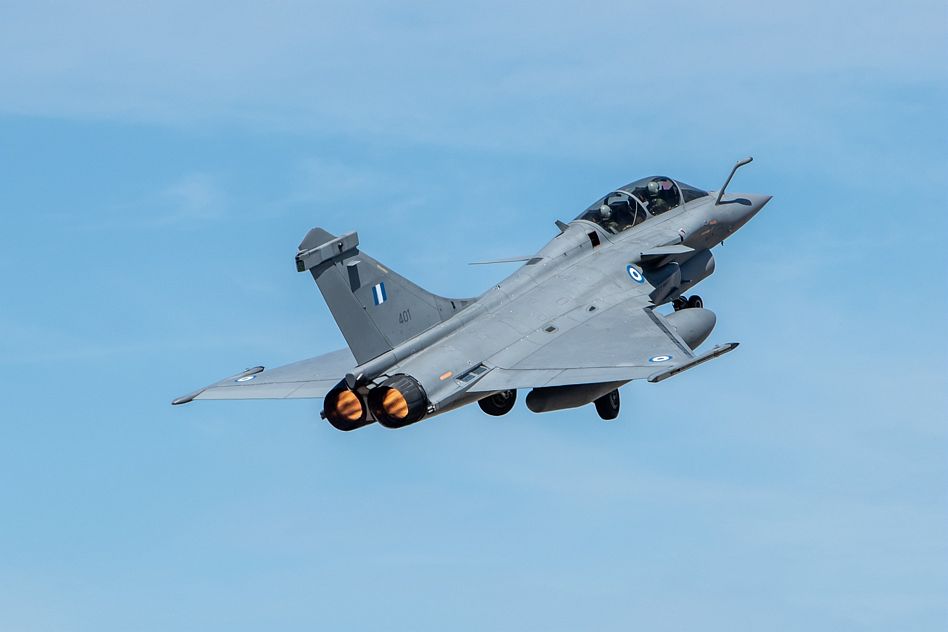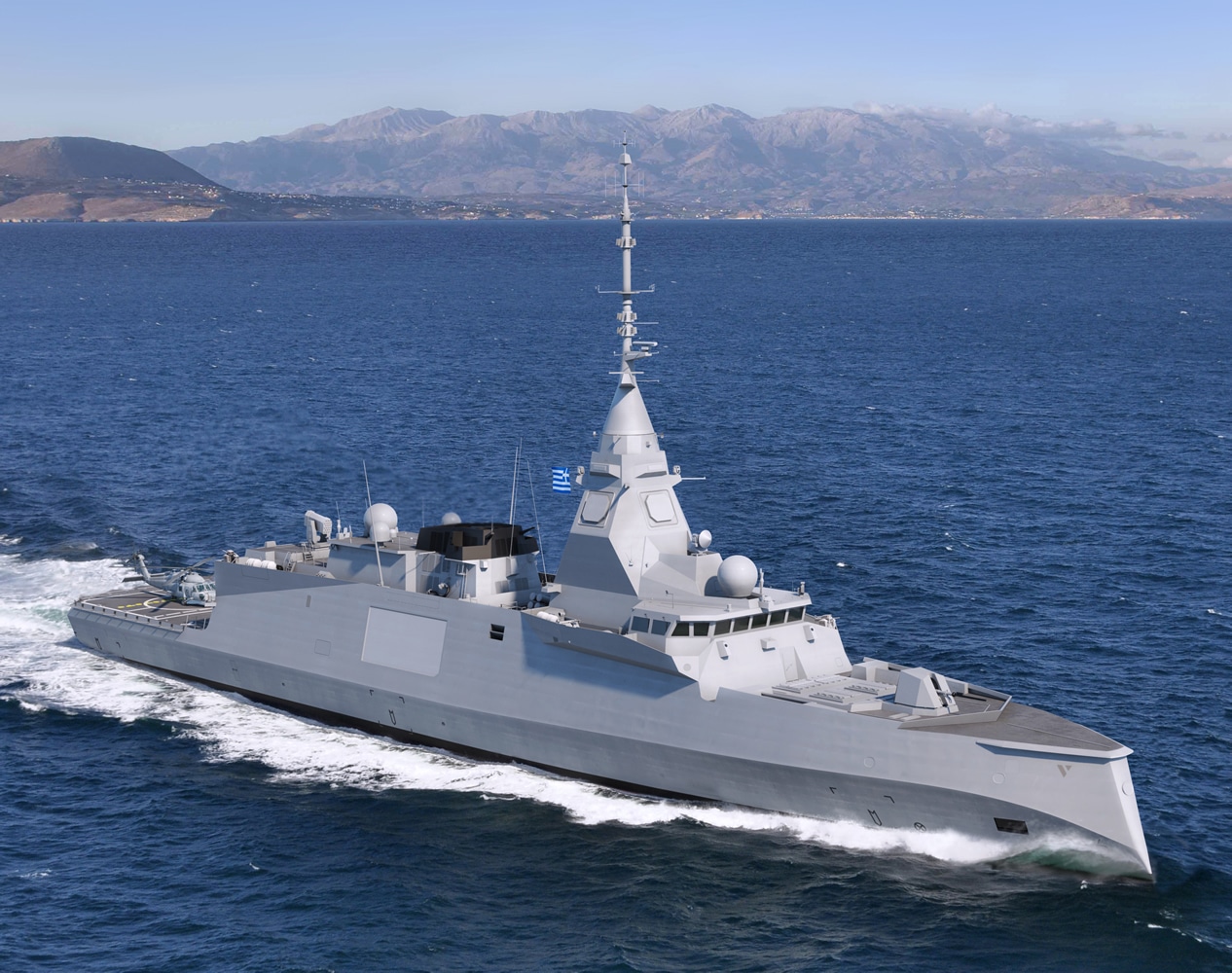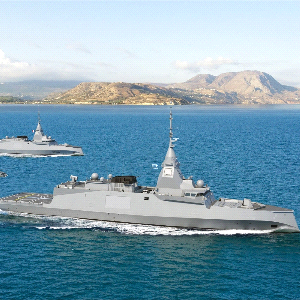The French-Greek FDI Frigates Agreement
Amsterdam, NL - October 04, 2021 -
Market Forecast Analytical Briefing on the French – Greek FDI Frigates AgreementOn Tuesday 28 September Greece has taken the final step towards the acquisition of new frigates with the signing of an MoU, initiating the negotiations that would lead to the signing of a final agreement, complemented by a strategic military cooperation agreement.
This analytical insight will shed light on Greece’s decision, the dynamics that shaped its decision and what the political aspect signify for the future.
The MoU was signed in Paris by President Emmanuel Macron, Prime Minister Kyriakos Mitsotakis and, the Defence and Foreign Ministers. The negotiations go back to 2017-2018 when the two sides signed a similar MoU that granted Naval Group a two-year negotiations exclusivity. In other words, the Greek MoD would only discuss with the French side for the procurement of new frigates.
Hellenic Navy’s requirement
The Hellenic Navy’s initial requirement was for six Area Air Defense (AAD) frigates. However, the initial negotiations for the FDI led to the potential procurement of only two due to their high price, which was around US$3.4 bn. The increased price was the result of the requirement to integrate additional launchers, missiles and CIWS compared to the French variant.
The Greek government also wanted the frigates’ acquisition program to revive its shipbuilding sector or at least one of its shipyards and its supply chain. The two frigates that was part of the previous round of discussions were not deemed adequate for the amount of investments that would be required to build them locally.
 Having previously “shaken hands” with President Emmanuel Macron, the unsuccessful closure of the negotiations was an awkward moment, which allegedly led to the procurement of Dassault Rafale fighter jets. Without any previous discussions and despite that the Greek defense minister stated in 2020 that there’s a need for 40 new fighter aircraft by 2025, the Greek government announced the procurement of 18 Rafale, without any option for additional ones. However, a few months later (September 2021) it announced the acquisition of six more, to complete one squadron.
Having previously “shaken hands” with President Emmanuel Macron, the unsuccessful closure of the negotiations was an awkward moment, which allegedly led to the procurement of Dassault Rafale fighter jets. Without any previous discussions and despite that the Greek defense minister stated in 2020 that there’s a need for 40 new fighter aircraft by 2025, the Greek government announced the procurement of 18 Rafale, without any option for additional ones. However, a few months later (September 2021) it announced the acquisition of six more, to complete one squadron.After the failure to agree on the FDI, it was clearly understood that any two AAD frigates would cost around the same amount of money, that two units were not adequate to invest in local shipbuilding and that the process should become more competitive with the inclusion of more parties. That’s when the Greek PM announced the procurement of four general-purpose frigates.
It was an unofficial competition, but without ever announcing the specifications. What was known was that the MoD was also looking for two used frigates to use as an interim solution during the upgrade of the MEKO-200HN, which was the third element of the generic requirements. The fourth element was that the government was looking for an investor for its shipyards.
Finally, after that companies had submitted several “updated” offers, the MoD ended up with the French.
The AUKUS agreement seemed to be the catalyst. In its aftermath the interaction between France and Greece increased. However, by applying basic international relations concepts, it would be easy to expect that AUKUS would have an impact on the French offer to Greece. Naval Group’s loss of the US$66 bn program would put a tremendous burden to the company which had no contracts in the pipeline. That brought the two sides closer.
The shipbuilding element
According to the MoU that was signed, and the statements made by Emmanuel Macron and Kyriakos Mitsotakis, the two sides would begin the discussions on the details for three FDI-HN frigates, before signing the contract. Officials from both sides have put the signing of it in the coming December. Is it necessary to spend three additional months before signing the agreement when the two parties have been in discussions for more than three years?
Even though there was no announcement by the two state officials, it has been widely publicized that Greece is also discussing the acquisition of three Gowind corvettes from Naval Group with one more as an option. Hence, the alleged three additional months. However, Defense Minister Nikos Panagiotopoulos said on 29th September, during an interview on the Greek SKAI TV station, that the corvettes are another issue, which has just started being discussed and it is not known yet whether the contract for them would be signed by Christmas.
With regards to the FDI, the Hellenic Navy seems to lean closer to the French variant, but with the addition of the Raytheon RAM close-in weapon system (CIWS) and an EW suite which will be integrated at a later stage. The rest of the weapons would include 32 Aster 30 B1, four MM40 Exocet Block 3C, a Strales 76mm main gun, two remotely-operated weapon stations and two twin MU90 torpedo launchers. The 3+1 frigates would be built at Naval Group’s site in Lorient at an estimated cost of US$3.47 bn.
For the Gowind-class corvettes, which will allegedly have a displacement of 2900 tons, Greek Media mention that they will feature similar weapons, with the exception of MICA-NG or any other equivalent in place of the Aster 30 B1. The alleged cost of these ships will be US$1.85 bn.
To make its offer more attractive, the French side decided to offer the second and third frigates that would come out of the shipyards in 2025. These were originally destined for the French Navy. The final FDI to Greece will be delivered in 2006. That is an extremely short delivery schedule that helps the Hellenic Navy withdraw three of its older Standard frigates (Elli-class).
If finally selected, the Gowind corvettes will be a new class of ships for the HN, after many decades. They are allegedly being considered in place of an interim solution as the first can be delivered sooner than the frigates, but with the advantage of being a newly-built. That would essentially cancel the requirement to upgrade the MEKO-200HN and the money would be transferred to the new program.
The shipbuilding program aims at creating a new fleet for the HN, which in the future it will need to replace nine Standard frigates (Elli-class), four MEKO-200HN frigates, seven Type 209 submarines and 12 fast-attack craft, among others.
Therefore, if the procurement of FDI and Gowind 2900 is finalized, then the HN could acquire six to eight main surface units until 2027-2028, almost replacing the whole Standard frigates fleet, at an estimated cost of US$5.33 bn. It is a huge step making the offer very attractive.
Industrial capabilities
The shipbuilding aspect of the MoU is not ideal for Greece, given that the FDI-HN frigates will be built in France. In the previous years the government was adamant about using this acquisition as an opportunity to bring one of the two biggest shipyards back to life, especially after ten years of severe economic austerity and the recent impact from the COVID-19 pandemic. It is oxymorous, but in the case of the FDI-HN, Greece is both supporting the French shipyards and not supporting its own.
There are a few arguments in favor of this decision. The first is that neither of the two big shipyards is in a position now or in the near future to start the shipbuilding process, due to the financial problems they have accumulated during the crisis. The second is that France offered a generous discount at the price. The third is the very short delivery time. The final one is that several Greek defense suppliers have been added to Naval Group’s FDI supply chain.
Indeed, as mentioned earlier, the frigates’ delivery schedule is more than ideal. It is also true that neither of the two main shipyards can implement the contract, but the officials have been discussing the procurement since 2018. Therefore, resolving the legal or financial issues of the shipyards’ sale should have been done in advance. Moreover, the offer to build the first unit abroad, to give time to the local shipyards to prepare, had always been an option from all the bidders that submitted their proposals.
Furthermore, Greece had ongoing negotiations with US government officials and the US DFC (Development Finance Corporation) on a series of potential investments in Greece, which also included the shipyards.
The US is particularly interested in them in order to have access to shipbuilding infrastructure that would be able to support the US Navy in the Mediterranean. It would also make sure that they would not be acquired by Chinese investors. For that reason, it had discussed the Lockheed Martin MMSC/HF2 proposal, and the alleged sale of second-hand Ticonderoga-class destroyers or LCS as interim solutions, with the willingness to invest in the shipyards.
Finally, Greece considers the cost of the frigates a very good price, worth the alternative cost of not building them locally. However, bear in mind that in countless defense contracts, in which countries (including Greece in the past) have opted to pay a premium to produce a system locally, support it independently at a lower cost, while also supporting their economy, rather than simply importing it at a lower price. It remains to be seen whether the final agreement will include provision for the establishment of local support capabilities.
At this point it is interesting looking at Polish Navy’s “Miecznik” (Swordfish) program, for three coastal defense frigates, with ASW and AAD capabilities. The new vessels will replace the O.H. Perry-class currently in service. The Polish MoD is highly engaging the local industry and supply chain, to maximize the return of the investment. The vessels will be built at PGZ shipyards with technology transferred by the manufacturer. The three companies that have been shortlisted are Navantia (F-100), Babcock (Arrowhead 140) and TKMS (A-300 PL). The first two were shortlisted in the Greek program as well.
On that aspect, the cost of the FDI-HN frigates, from which only a fraction of the total value is expected to be given to the local suppliers, is added to the contracts for the Rafale fighter aircraft (US$3 bn) and the Hellenic Air Force training center (close to US$2 bn). Both do not have any provisions for the local defense industry’s engagement.
Therefore, the Gowind program is the only one that could support the local shipbuilders. That is, as long as the Greek officials have resolved the problems associated with the shipyards. Otherwise, any delays mean that the Gowind deliveries will be closer to the those of the European Patrol Corvette (EPC) around 2027, in which Greece is a member along with France, Spain and Italy. Therefore, building two similar designs could potentially cause industrial and business conflicts.
The political agreement
From the previous lines it becomes easily understood that Greece is taking advantage of the fact that it will acquire new surface vessels at a short period of time, at the expense of not supporting its shipbuilding sector. At least for the time being.
However, it creates a strong alliance at the political level. Compared to the other bidders of the frigates program, only the US could probably submit such an integrated offer. France and Greece have agreed to regularly meet, discuss and coordinate their efforts in industrial and technological; military; and defense and security issues. NATO will remain the base of their collective defense and they will enhance the EU’s common security and defense policy, which will include shaping the EU’s defense policy. The two sides will often convene to discuss and if possibly coordinate their positions in NATO affairs, while enhancing the European pillar of NATO.
In the military domain, France and Greece have agreed to convene to discuss regional military affairs, hybrid threats, cyber-threats, the development of disruptive technologies and AI, maritime security, the development of interoperability and a common strategic culture. This cooperation can take multiple forms ranging from the exchange of students and staff to common training, provision of infrastructure, intelligence sharing and common deployment of forces (e.g. TF Takuba in Mali).
However, the most important element of this agreement is the clause for mutual support, if necessary, with the use of armed force, in case that any of the two sides is agreed to be under armed attack, according to Article 51 of the UN Chart.
Although such a close is included in NATO’s pact, the bilateral agreement further enhances that aspect. The continuing political-military row with Turkey is a major point of concern for Greece. It considers that neither NATO or the EU have done enough to reduce tensions and acts of aggression. The culmination of this stance in 2020 was the Turkish effort to push forcefully thousands of immigrants through the land borders at Evros region and the provocations with a research ship accompanied by combat vessels while sailing close to Cyprus and the Greek continental shelf.
France also faced issues with Turkey in the Eastern Mediterranean where Total Energies has drilling rights in EEZ of Cyprus. Moreover, during the NATO mission off the coast of Libya in June 2020, a French frigate was targeted by a Turkish frigate’s sensors suggesting an imminent attack, while attempting to get close to a merchant ship, to verify whether it was smuggling weapons to Libya.
Therefore, the bilateral agreement will significantly enhance the deterrent capabilities of both countries and mostly Greece. For France this agreement is also a reaction to the AUKUS agreement and Paris’ to define itself as the military pillar of the EU, especially after Brexit. However, with NATO still having that role in European defense and Germany focusing more on the economic aspects and less on sharing the defense burden, it will be difficult for France to assume this role.
Conclusion
The French-Greek agreement is a significant effort for the two countries to assume a more active role in the Mediterranean and especially in the Eastern Mediterranean region, with a clear impact on the Middle Eastern security. Let’s not forget that Greece signed a similar political-security agreement with the UAE and has enhanced its politico-military cooperation with Egypt and Israel. Moreover, Egypt is already operating Rafale aircraft and FREMM frigates, which will now improve jointness with the Hellenic Navy and Air Force.
For France it is a rare opportunity to support its defense industry and mostly its shipbuilding sector, especially after the blow from the loss of the Australian submarine contract. However, it is not the same for Greece, which after ten years of severe austerity and brain-drain struggles to attract investments and supporting its economy. The defense procurement projects are a great opportunity to invest in a niche market, maintaining highly-skilled jobs and bringing STEM professionals back.
In addition and despite the country’s borrowing to implement those projects, the return to the economy has been minimal, so far confined to some secondary procurement (e.g. light w
 eapons, ammunition, sensors etc.).
eapons, ammunition, sensors etc.).Greece’s defense spending is highly political and lacks open competitions and procedures. Further to that, the budget is not allocated to the chiefs of staff, but to the ministry to be spent according to the government’s decision, rather than according to the services’ planning. That is the case with the recent spending as well.
It is also rather “cyclical”, meaning that instead of spending in a “linear” way it implements large procurement programs, usually after a major event or crisis. Such investments took place after 1996, in the aftermath of the crisis with Turkey, when the Greek government realized it lagged in capabilities. However, at that time the defense industry was highly involved.
Besides the previous government’s 2018 decision to upgrade the P-3 Orion and of the F-16 to the Viper variant with the help of the Hellenic Aerospace Industry, the current spending could have been a golden opportunity for its defense industry and economy.
Moreover, Greece wants to maintain a deterrent capability. The procurement of the Rafales and if successful, of the FDI-HN and Gowind 2900, are a major upgrade to its capabilities. The Hellenic Navy will possess AAD and ballistic-missile defense capabilities, while the Hellenic Air Force will have a serious qualitative advantage in the region, especially after Turkey’s exit from the F-35 program.
Nevertheless, the incremental procurement of the Rafales shows lack of planning that will combine capabilities and the industrial aspect. It is easy to understand that deterrence is a wider concept that does not only include the possession of advanced platforms. It includes, among many others, the economy’s ability to support defense and welfare, of the industry to be sustainable, able to develop technologies and of course supporting the current capabilities. Further to that, throughout the last decades Greece has shown that it acquired state-of-the-art platforms but didn’t equally invest in the concept of network-centric warfare, which is the core of modern warfare.
The bilateral agreement can benefit the Greek side from the interaction with the French Armed Forces and, the operational and technological aspects of it. The joint deployments will provide combat experience to the Hellenic Armed Forces. As for the cooperation in the defense industry domain it has the potential to offer new opportunities for both sides.
The process is not expected to be easy. The upcoming global economic situation and the EU’s post-pandemic return to the stability pact rules will put pressure to the Greek economy, which might be required to reduce spending in other areas to fund defense acquisition. That is a potential source of risk for the implementation of the several defense projects, including that of shipbuilding.
By Stelios Kanavakis, Lead Analyst Market Forecast

Image Source: Naval Group